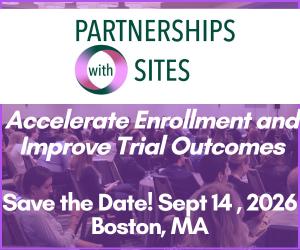Vanderbilt University's Platform to Connect Researchers and Patients
Loretta Byrne explains how Vanderbilt University built a research matching platform to lower the barriers to learn about and participate in clinical research. Ms Byrne is a research services educator at Vanderbilt University Medical Center and the project manager for the national NCATS-funded platform, ResearchMatch.org.

What is ResearchMatch and the impetus for it being formed?
ResearchMatch is an online platform that connects people who are interested in learning about research opportunities with researchers who need them. I would say this is the first and only platform of its type. One for patients and all people who are interested in research – from the community – beyond the walls of the academic medical center. People who can essentially raise their hands by joining ResearchMatch, and let me know, say as a research nurse specialist in clinical pharmacology back in 2010, that they are a potential participant who might like to take part in my study, and that I should give them a call. It connects researchers to that community in a secure and de-identified manner.
ResearchMatch started at Vanderbilt University Medical Center in 2009. Dr Paul Harris is the principal investigator and creator. It was formed with support from the CTSA consortium, and is NIH-funded. I was a research nurse specialist in clinical pharmacology and an early user of ResearchMatch because Dr Harris came to me, and he asked me about how I was recruiting for studies. He was taking the pulse of the entire institution – and institutions like Vanderbilt – and assessing what the needs of the researchers were and what the needs of the public were.
From my perspective as a researcher at that time, it was, and continues to be, very challenging to recruit participants into complex studies. But back in 2007- 2008, researchers were really having a hard time. I was relying on emails, flyers, word of mouth, and direct participant referrals.
How does ResearchMatch connect researchers and patient volunteers?
If you were to volunteer, it takes about 5-10 minutes to fill in questions about your health conditions, the medications you’re taking, and create a username and password, so that your information is protected.
We validate your email. You also sign an agreement that explains what ResearchMatch does and does not do. You provide your name, home address, email, phone number, your demographics – race, ethnicity, gender, height, weight – smoking status, and any medications or health history you want to share. After that, you’ve created your profile in ResearchMatch and you wait for researchers to contact you.
The other set of stakeholders are the researchers. They’re coming from the institutions that have joined ResearchMatch. ResearchMatch validates that they work at the institution; the researcher signs an agreement that they understand the rules and how ResearchMatch works. Once they have joined ResearchMatch as a researcher they can register their study. The study has to be IRB-approved, and have an IRB-approved message to be sent out by ResearchMatch.
There is nobody on the ResearchMatch Vanderbilt team who is matching people on the back end; ResearchMatch does not work that way. This is driven more by the researchers coming on and using the filters. They are inputting the demographics of their cohort based on their inclusion and exclusion criteria for the study that they have registered.
How does the filtering work?
For example, let’s say somebody is looking for men between 40 and 60, who are at risk for diabetes. They would put that into the demographic filter and might apply the geographic filter as well. They may be looking all across the US, or maybe within 50 miles of their institution, when the participants are asked to make several visits throughout the study period.
The researcher applies more demographics, like race and ethnicity, then health criteria and medications. Through that, they create a cohort, but the potential participants are still de-identified. Let’s say this researcher has now narrowed it down to 58 men between 40-60 at risk for diabetes that are within 50 miles of their institution.
They submit their IRB-approved message, and ResearchMatch sends an email to those individuals which includes the message embedded into a template. The template header states “It looks like a researcher at Mayo Clinic believes you might be a good match for the following study,” followed by the approved message. If the volunteer expresses interest in learning more about the study by stating ‘Yes’, then and only then is their information released to the researcher.
If the volunteer isn’t interested, their anonymity is protected. If the volunteers say yes, they’re not consenting to be in the study; they’re only agreeing to release their name, home address, email and phone number along with their profile information to this researcher.
Can you illustrate some of the impacts from ResearchMatch?
In some ways it is challenging to evaluate the impact in hard numbers because we have to rely on the researchers to provide that feedback to us. Tens of thousands of people have actually been enrolled in studies because of ResearchMatch, but that metric is incomplete because researchers are very busy people, and they don’t provide comprehensive enrollment feedback.
Essentially, ResearchMatch is a matching tool. It assists the researcher to create a list of individuals who are interested in learning about their study. Once the potential volunteer expresses interest and shares their contact information, that is essentially when the match is made. The researcher then has the responsibility of contacting, recruiting, enrolling them, and conducting the study. That’s beyond the purview of the platform.
Our vision is to provide a platform for the public to learn about studies, because lack of awareness of clinical research is a big barrier to trial enrollment. One indicator that we use to measure utility and success is the percent of people being contacted and the percent being matched. We’re up to roughly 158,000 volunteers. As of last month, 99% of them have been contacted at least once with an opportunity to be in a study. Of the 99% that are being contacted, 60% are saying ‘Yes’. We’re thrilled with that, but there is another 40% that are not saying yes. That’s something that we focus on and work to improve, in other words, what is within our scope to make a difference. Other indicators are the continuous enrollment of volunteers and researchers, and our trajectory is always going up.
We’re concentrating now on raising awareness and improving the diversity of the ResearchMatch population. Right now, the population in ResearchMatch, there’s a majority of people in their late 20s to 30s, and the majority are white women. So, we’re looking at how we can improve that. As we do that, we assess other indicators around activity and engagement on the platform; what are our volunteers doing on this site. Are they staying engaged? Are they getting what they wanted?
"We need to train researchers and help them to have the support needed to get out into the community – through the institution. We put a lot of burden on a researcher to do all of these things; to be going out into the community and helping, but the institutions need to facilitate that as well."
Are patients able to search for studies on their own in addition to waiting for researchers to contact them?
In 2017-2018, we started customizing volunteers’ dashboards with studies that might be a perfect match. Volunteers now see a customized list of clinical research trials that are going on across the country based on their health condition and their demographics. We strive to connect them with studies that might interest them from our ‘sister’ site to ResearchMatch called Trials Today. Trials Today is a clinical trial search engine also supported by our NIH grants which is pulling in information from ClinicalTrials. gov and making it a little bit easier to navigate.
There’s one question on Trials Today that helps the user identify what their desires are, what they are looking for in a study, and then it filters through the studies that are available and offers those in an easy to navigate list. In addition to our essential matching process, patients and the public are welcomed to share their information with study teams on these clinical trials via in a secured manner with the help of Trials Today and ResearchMatch.
So, in addition to integrating Trials Today with ResearchMatch, Volunteers have the opportunity to tell ResearchMatch how far they’re willing to travel. That’s a key piece of information that ResearchMatch needs to make a better match. But there may be trials in a city 600 miles away, but they’ll never know about them if they said they only wanted to drive 50 miles.
The volunteer can also share their ideas with researchers on their dashboard; they can see educational resources from MedlinePlus, and be connected with information and resources through nonprofit organizations like the American Lung Association.
What is the hope for ResearchMatch in the next 3-5 years?
It would be nice to have more awareness of ResearchMatch and to see it reaching more communities. The teaming up of the research world with the community engagement world is so important. We need to train researchers and help them to have the support needed to get out into the community – through the institution. We put a lot of burden on a researcher to do all of these things; to be going out into the community and helping, but the institutions need to facilitate that as well. In the future, my hope is that these will be part-and-parcel.
Research is a way to get a seat at the table and be part of more health equity discussions in the United States. Everybody needs to be involved in research; the vaccine studies are such a great example of why all of us need to take part in research. The pandemic has also pointed out the health disparities that are happening across the country, so I would like to see more integration of research opportunities into the community facilitated by the institutions, so it is easier for the community to participate and possible for the researchers to engage with people in the community.
For more information on CRAACO: Clinical Research as a Care Option, visit CRAACOevent.com.






